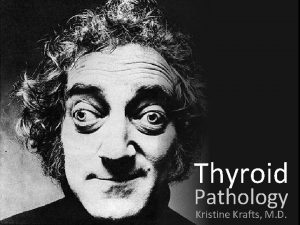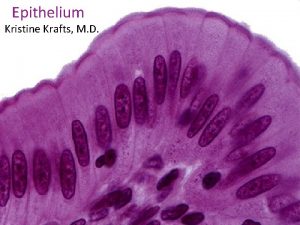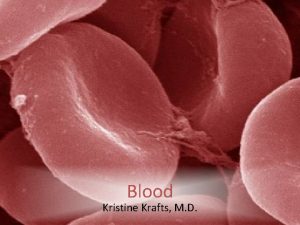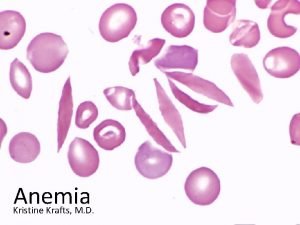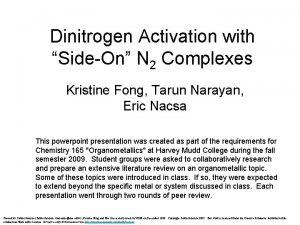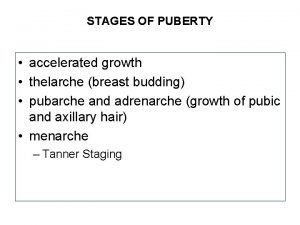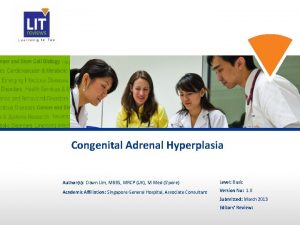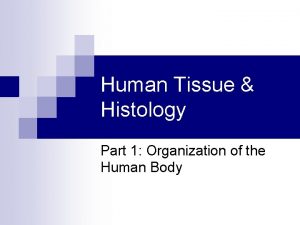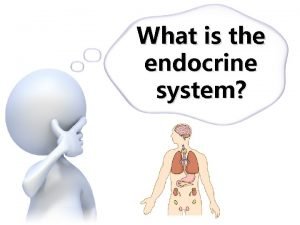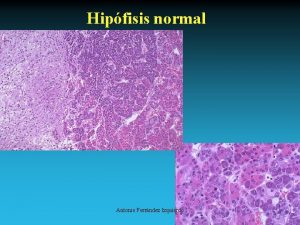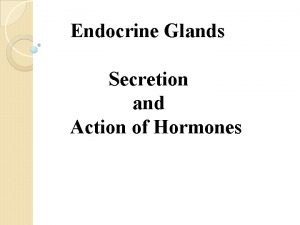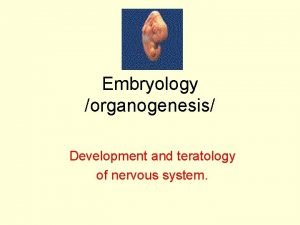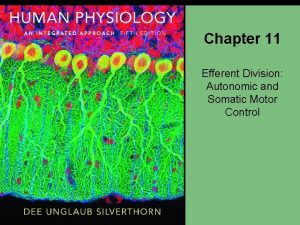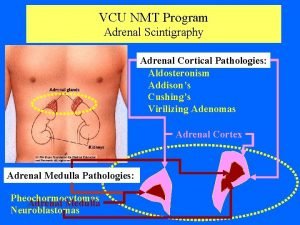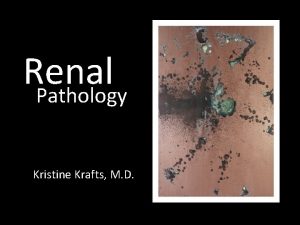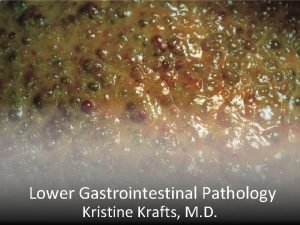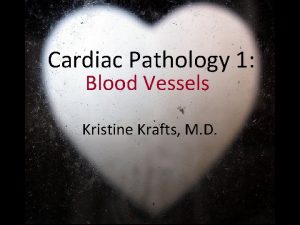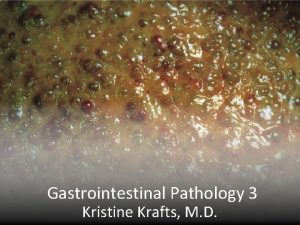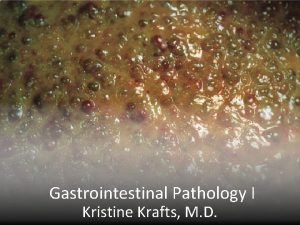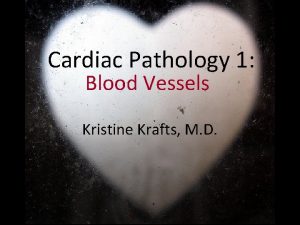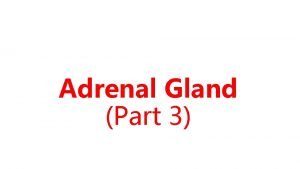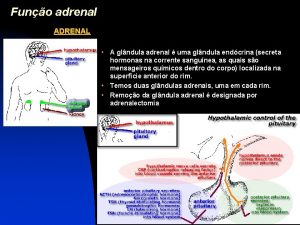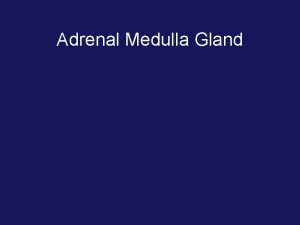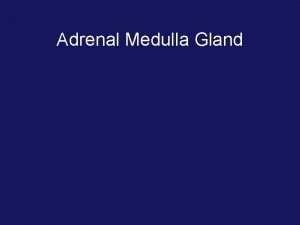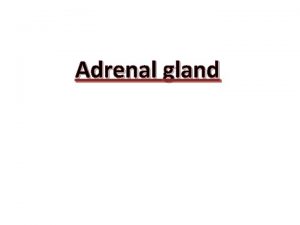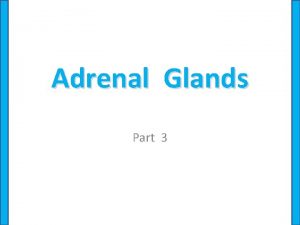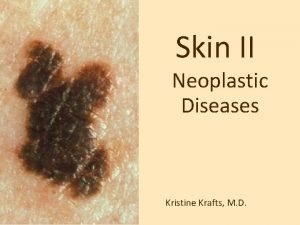Adrenal Pathology Kristine Krafts M D Adrenal Path













































- Slides: 45

Adrenal Pathology Kristine Krafts, M. D.

Adrenal Path Lecture Outline • Introduction • A disease with too much hormone: Cushing syndrome • A disease with too little hormone: Addison disease • Tumors of the adrenal

Adrenal Path Lecture Outline • Introduction

Adrenal gland anatomy

Mineralocorticoids (e. g. , aldosterone) Hormones: Zona glomerulosa Capsule Zona fasiculata Zona reticularis Glucocorticoids (e. g. , cortisone) Sex hormones e. g. , dehydroepiandrosterone) and Adrenalin Noradrenalin Medulla Adrenal gland histology and hormones

Adrenal Path Lecture Outline • Introduction • A disease with too much hormone: Cushing syndrome

Cushing Syndrome • Elevated serum cortisol • Clinical features: • Hypertension • Characteristic pattern of weight gain • Hyperglycemia • Thin skin • Depression • Most common cause: exogenous steroids

Cushing syndrome: buffalo hump

Cushing syndrome: moon facies

Causes of Cushing syndrome

Adrenal Path Lecture Outline • Introduction • A disease with too much hormone: Cushing syndrome • A disease with too little hormone: Addison disease

Addison Disease • Also called primary chronic adrenal insufficiency • Decreased serum cortisol and mineralocorticoids • Most common cause: autoimmune attack on adrenal cortex • Eventually fatal if not treated

Symptoms of Addison Disease • Early: signs are vague (weakness, fatigue) • Later: skin bronzing/hyperpigmentation • Eventually: serious complications (hypotension, electrolyte imbalances) • Misdiagnosis is not uncommon

Why is there hyperpigmentation in Addison disease? Cortisol ACTH Normal ↓ Cortisol Addison Disease

Hyperpigmentation in Addison disease

33 year-old female with no prior medical issues. Day 1 prior to admission • Headache Day 2 prior to admission • Very fatigued, vomiting Day of admission • Husband brought to ER • Vision loss right eye • BP 100/60 • Given IV fluids

Day 2 post admission • Right-sided paralysis • Oxygen levels dropping • CT: brain swelling Day 3 post admission • Coma • BP 70/33 despite IV fluids • 40 pound weight gain Day 4 post admission • No brain activity • Acute renal failure • “Nothing else can be done. ”

Day 5 post admission • Different doctor • IV Na+, hydrocortisone, dextrose Day 6 post admission • Opened eyes Day 10 post admission • IV removed

In ensuing weeks • Feeding tube removed • Intensive speech, physical, occupational therapy Two months later • Back to work • Feeling normal • Must take steroids daily for the rest of her life

Adrenal Path Lecture Outline • Introduction • A disease with too much hormone: Cushing syndrome • A disease with too little hormone: Addison disease • Tumors of the adrenal

Pheochromocytoma • Derived from adrenal medulla cells • Cells produce epinephrine • Patients present with hypertension • Usually benign • Diagnosis: epinephrine breakdown products in urine

A couple good pheo mnemonics The 10% tumor Pheo symptoms • 10% occur outside • Paroxysms of. . . the adrenal • 10% bilateral • 10% familial • 10% malignant • Pressure (hypertension) • Perspiration • Palpitations (tachycardia) • Pallor

Neuroblastoma • Derived from neural crest cells • Relatively common childhood tumor • Prognosis better in: • Children < 18 months • Lower stage/grade • Hyperdiploid tumors • Fewer copies of N-myc

MEN Syndromes

Brad Pitt vs. John Cleese









No contest!

MEN Syndromes • Inherited disorders that predispose patients to getting endocrine tumors • MEN-1 and MEN-2 (A and B) • MEN tumors are much more aggressive than sporadic tumors

MEN Syndromes Ridiculously Simplified MEN-1 MEN-2 Thyroid Not much Medullary carcinoma Other Endocrine Organs Hyperplasia, adenoma, carcinoma Not much

MEN Syndromes Ridiculously Simplified MEN-1 MEN-2 Thyroid Not much Medullary carcinoma Other Endocrine Organs Hyperplasia, adenoma, carcinoma Not much

MEN I Clinical Features • Parathyroid hyperplasia • Pancreatic endocrine tumors • Pituitary adenoma

MEN I Genetics • MEN 1 gene mutation • Tumor suppressor gene • Encodes menin • Mutation turns off the gene

MEN-1 Pitt-uitary adenoma MEN 1 gene run-of-the-mill inactive turn off

MEN Syndromes Ridiculously Simplified MEN-1 MEN-2 Thyroid Not much Medullary carcinoma Other Endocrine Organs Hyperplasia, adenoma, carcinoma Not much

MEN 2 A Clinical Features • Medullary thyroid carcinoma • Pheochromocytoma • Parathyroid hyperplasia

MEN 2 A Genetics • RET gene mutation • Proto-oncogene • Encodes tyrosine kinase receptor • Mutation turns gene on

MEN 2 B 2 B has most of the features of MEN 2 A • Medullary thyroid carcinoma • Pheochromocytoma • RET gene mutation But it’s slightly different • No parathyroid involvement • Patients are “marfanoid”

MEN-2 Cleese-cell hyperplasia b. RETon gene of a kind always turned on
 Kristine krafts
Kristine krafts Real chromosome
Real chromosome Kristine krafts
Kristine krafts Art
Art Kristine krafts
Kristine krafts Kristine krafts
Kristine krafts Aplastic anemia
Aplastic anemia Unity signalr
Unity signalr Kristine tveit
Kristine tveit Kristīne madelāne
Kristīne madelāne Bo bendtsen
Bo bendtsen Sahar anwar
Sahar anwar Kristīne freiberga
Kristīne freiberga Kristine nagel
Kristine nagel Kristīne detkova
Kristīne detkova Dr noza
Dr noza Kristine atiyeh
Kristine atiyeh Kristine kousholt
Kristine kousholt Kristine nutt
Kristine nutt Kaitlin bonner
Kaitlin bonner Kristine hanna
Kristine hanna Kristine ruggiero
Kristine ruggiero One source multi use
One source multi use Kristine casey
Kristine casey Kristine fong
Kristine fong Kristīne bernarde
Kristīne bernarde Kristine brosjö
Kristine brosjö Kristine kopperud timberlid
Kristine kopperud timberlid Thyroiditis
Thyroiditis Aydede yüz
Aydede yüz Congenital adrenal hyperplasia characteristics
Congenital adrenal hyperplasia characteristics Visceral nervous system
Visceral nervous system Congenital adrenal hyperplasia electrolytes
Congenital adrenal hyperplasia electrolytes Adrenal gland epithelium
Adrenal gland epithelium Adrenal glands
Adrenal glands Adrenal gland
Adrenal gland Adenoma
Adenoma Cow adrenal gland
Cow adrenal gland Adrenal cortex develops from
Adrenal cortex develops from Zone of adrenal cortex
Zone of adrenal cortex Zona reticularis
Zona reticularis Neural plate formation
Neural plate formation Objectives for stress management
Objectives for stress management Adrenal sympathetic pathway
Adrenal sympathetic pathway Adrenal cushing
Adrenal cushing Dr wilson adrenal rebuilder side effects
Dr wilson adrenal rebuilder side effects


